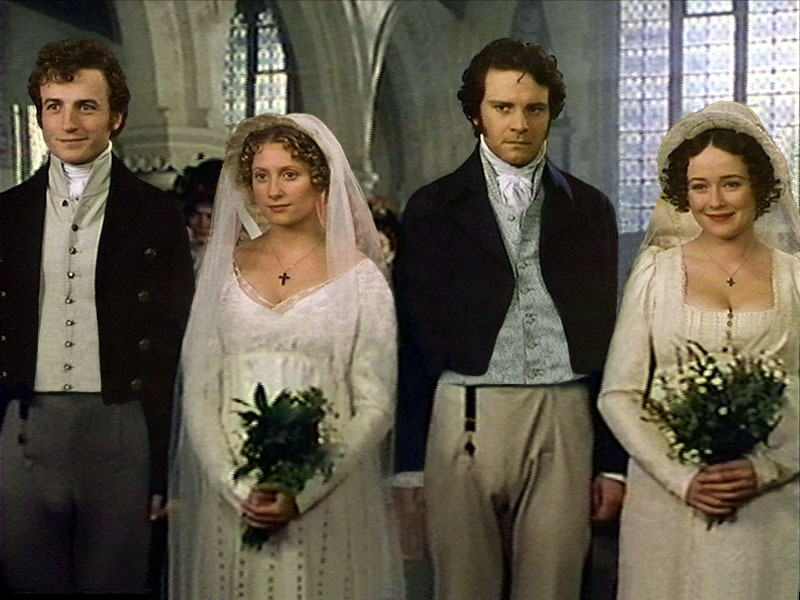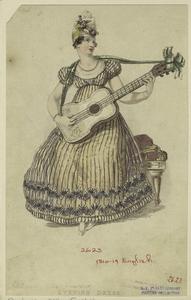I'm sure you're familiar with the story of Pride and Prejudice. Even if you've never read it or seen an adaptation, the story is a huge part of our culture. It's the ultimate classic novel, and by extension, the ultimate costume drama.
When I say "the ultimate costume drama," I'm of course referring to the 1995 adaptation, in all its five-hour, Colin Firth-y glory. My mom was the one who got me started on this adaptation when I was just a wee child. I've since seen it upwards of twenty times. Not to toot my own horn, but I can also quote pretty much every scene word-for-word. It's the film that got me started on Jane Austen, and it's been a big part of my life for a long time. It's our feel-good movie. Whenever we're having a bad day, we pop in the disc and watch an hour of it here or there. It doesn't even matter whether we watch it in order or not. We're sucked into the beautiful story every time.
So, without further adieu, let's take a look at the costumes worn by that singular, indefatigable, beloved Austen heroine, Elizabeth Bennet.
If you're a fan of reading
IMDb trivia pages like I am, you'll know that the BBC loves to reuse costumes. The page for pretty much every British period drama has a piece of trivia that reads like this:
The green striped gown with velvet Spencer jacket Anna Chancellor (Caroline Bingley) wears at Netherfield Hall is the same costume worn by Julia Davis (Elizabeth Elliot) at Kellynch Hall in Persuasion, Vicki Pepperdine (Ann Dobbin) in the park scenes in Vanity Fair, and an extra at the London party where Annabella Milbanke meets Byron in Byron. The Spencer also appears, without the striped gown, in Little Dorrit, worn by Emma Pierson as Fanny Dorrit.
This means that several of the costume pieces in Pride and Prejudice weren't built specifically for the production. The real design of the costume lies in how the designer selects, matches, and styles the various pieces. Let's take a look.
The first time we meet Lizzy is when she's on a walk near her home. She's wearing a simple day dress, a structured spencer jacket, and a bonnet. This scene and her outfit set the tone for her character- she's outdoorsy, adventurous, and free-spirited, but still sensible and put-together.
Lizzy's costumes, unlike those worn by the ladies around her, aren't fussy in the least. This sets her apart from the other women and shows her independent nature. We'll see several variations on the dress, spencer, and bonnet combo as the story progresses.
Elizabeth's day dresses are equally simple. They're usually white or have some sort of subtle pattern (as seen in the image above), and they show her no-nonsense personality well. Check out the image below and compare Lizzy with the rest of her sisters. She's the only one who isn't wearing a pattern, and her dress is a demure cream color.
One of Elizabeth's more elaborate day dresses is also my favorite. The coral dress she wears at Netherfield is one of my favorite Regency costumes of all time. The cheery color compliments her well, and it's very vibrant compared to the rest of her relatively tame wardrobe.
Of course, no analysis of Elizabeth's costumes would be complete without the iconic white ballgown that she wears at the Netherfield ball.
This is pretty much your textbook Regency era ballgown. White was a popular color for young women because it looked great in candlelight. The short sleeves and gloves line up with both the fashion and the etiquette of the time. The one thing that makes this outfit stand out is her floral ribbon crown. Yet again, we see something that's beautiful in its simplicity, and some very smart fashion choices on Lizzy's part.
To round it all out, we have the final scene of the mammoth drama, in which Lizzy and Darcy get married.
It looks like Lizzy's wearing a long-sleeved white gown with pleating and buttons on the bodice, and some sort of white pelisse on top. Elizabeth and Jane are both wearing white, which I've touched on before, and it's interesting to see how both of their wedding gowns express their personalities. Elizabeth's is simple and structured, while Jane's has demure lace accents and a more feminine cut.
That wraps up this week's Fashion in Film post! It's been so fun to write about one of my family's favorite films, especially on the day before Thanksgiving. I hope you have a lovely holiday, and I'll see you next week. God bless.
Bonus Round: Check out
this amazing analysis of different adaptations of the Netherfield ball. It has some great info on Regency era fashion and ballroom etiquette.

























